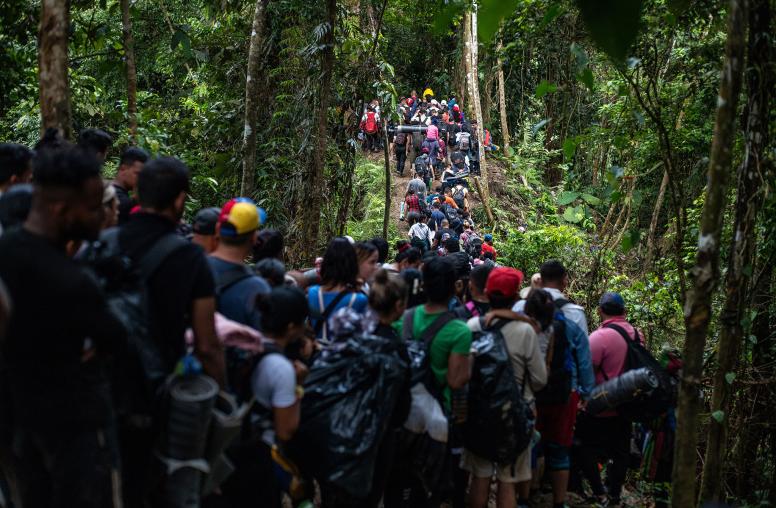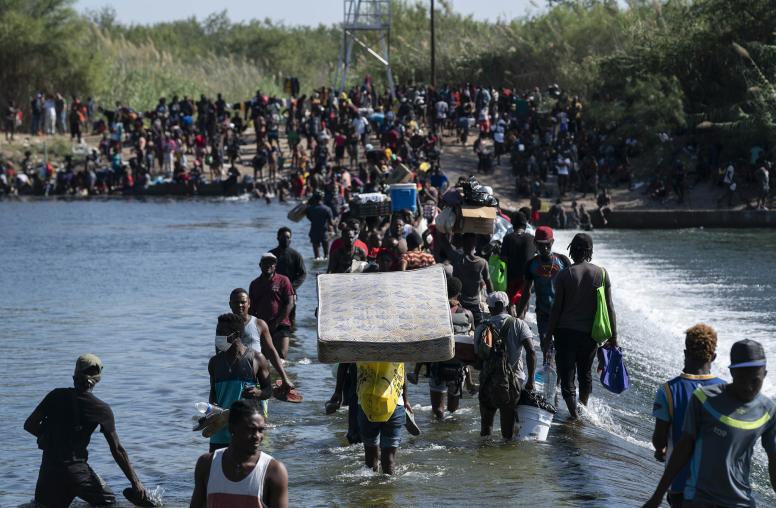Fragile States Provide Extremists Fertile Ground to Recruit and Grow
Promoting transparent, accountable and responsive governance and restoring social cohesion are key to building resilience and thwarting terrorism.
Editor’s Note: Below are the excerpts of an interview originally published by the European Eye on Radicalization with USIP’s Mona Yacoubian about the various drivers of terrorism and constructive ways to address the phenomenon. She says the fragility of states provide an enabling environment for terrorists to operate and underscores the various ways that extremists benefit from this environment.

How important is state fragility — as compared to, say, ideology — when it comes to enabling terrorism?
I think it’s difficult to assign a relative measure of importance or significance when comparing state fragility to ideology or other drivers of terrorism. Terrorism arises from a web of causal factors that interact with each other to contribute to the phenomenon.
Several years ago, my colleague Paul Stares and I developed what we called an “epidemic model” to help understand the spread of violent extremism. We concluded that terrorism does not arise in a vacuum. Ideology was a factor, but far from the only one.
State fragility certainly has a key role to play in facilitating the spread of extremism. Time and again and across disparate regions of the world, we’ve seen where corruption, repression, poor governance, inadequate public services and a lack of accountability contribute to the rise of extremism and recruitment into terrorist groups.
In 2019, the U.S. Institute of Peace published an in-depth report detailing the connection between fragility and extremism and recommended a strategy focused on prevention of extremism in fragile states through a multifaceted approach that highlights the need for inclusive institutions, accountable governments and broad civic participation.
Operationally, how do terrorist organizations benefit from fragile states?
Fragile states provide an enabling environment for terrorist organizations to operate — both because the state security capacity likely isn’t robust enough to reach the periphery of the state and because the elements that abound in fragile states (corruption, relative depravation, broken governance, marginalization, etc.) are the same factors that play outsized roles in driving violent extremism.
As such, terrorist organizations benefit from state fragility in multiple ways including financing, recruitment and indoctrination. In some instances, they exploit ungoverned areas where security vacuums arise to organize themselves and exert their control over local populations. While they may not explicitly control territory, they fill these vacuums of government authority in a variety of ways.
They can, for example, establish temporary checkpoints or intimidate and extort local populations through night visits and other means. As witnessed a decade ago in Iraq and Syria in vast ungoverned spaces — particularly along porous borders — terrorist groups intersect with insurgents and criminal networks exacerbating fragility and violence. These dynamics in ungoverned border areas are now seen across Africa, particularly along east-west transit routes through the Sahel belt and the north-south movements in East Africa.
Extremists also benefit from weak or absent governance by seeking to provide essential services where governments fall short. State fragility can also be a boon to terrorist recruitment. They may recruit members via economic incentives by offering salaries in places where poverty and unemployment are high. To the extent that fragile states can project their security forces, they often commit human rights abuses with impunity when doing so, furthering a sense of grievance among the population.
State fragility is usually accompanied by social and economic challenges such as poverty and famine. How does state fragility interact with these other problems to allow indoctrination and recruitment?
Socioeconomic grievances arising from poverty and food insecurity are often intertwined with state fragility and by extension can play a role in facilitating recruitment and potentially indoctrination. We have seen this recently in Lebanon, which has endured an historic economic collapse, largely due to government malfeasance and ineffectiveness.
As a result, Lebanon is witnessing unprecedent levels of poverty and food insecurity. Increasingly, stories have emerged of young men from Tripoli — one of Lebanon’s most impoverished cities — being recruited by ISIS. Poverty has been cited as one of the reasons young men opted to join ISIS.
Where state authority has evaporated and terrorists have grown powerful, for example Somalia, is there any option short of an external occupation — what would once have been called a Mandate — to restore order?
External occupation is by no means a panacea for addressing the absence of state authority. Often, external occupation can itself become a driver for extremism, especially in cases where local populations feel disempowered, disenfranchised and lacking dignity.
Ideally, engaging in policies and strategies that address state fragility before the total collapse of state authority is far preferable. However, in the event there is a complete breakdown of state authority, models of engagement that employ a small external military footprint and work to address security vacuums “by, with and through” trusted local forces are the best option.
The Global Coalition to Defeat ISIS employs this model in northeast Syria with local Kurdish forces serving as the primary partner on the ground. While it is far from perfect, the model has yielded important positive results. Another example is the success of regional forces in Mozambique — which may help mitigate unintended consequences of “foreign” occupiers from further afield.
At the same time, it is essential that stabilization assistance also address directly issues around governance and service provision, perhaps working largely with local governance entities and engaging with communities and civil society organizations.
In a state like Iraq, where militias (some of them designated terrorists) have most de facto control, is there anything that can be done to move the situation back toward legitimate authority?
The proliferation of non-state actors and militias constitutes a critical challenge to state authority. Strengthening state security institutions is foundational to moving back toward legitimate authority. But building back state authority in places such as Iraq that are contending with powerful militias — in this case supported by a powerful external actor, Iran — is a complicated issue that demands time, resources, and the political will to rebuild state security institutions.
Training and supporting Iraqi state military forces including the elite Iraqi Counter Terrorism Service is critical to addressing security voids that give rise to non-state militias in the first place. Far more difficult is the task of demobilizing and disarming militias, which requires a long-term, multidimensional strategy that addresses the complex roots that give rise to militias — security vacuums, political grievance, economic and social dislocation — and devises responses to combat these drivers.
What can external powers do to shore-up fragile states and prevent terrorist organizations from growing in such a fertile environment?
External actors have an important role to play in helping to build resilience and promote stability in fragile states as a part of a broader prevention strategy. Promoting transparent and accountable governance that is responsive to the needs of local populations and restoring social cohesion in divided societies are just two elements of such a strategy.
More broadly, the international community should commit to some essential principles when engaging fragile states. These principles include the need to build strong local partnerships; the willingness to adopt longer term time horizons, and a commitment to pursue a “whole-of-government” approach that highlights diplomacy and development rather than a security-centric approach.
In the United States, the 2019 Global Fragility Act embodies this new approach. The challenges ahead are no doubt daunting, but innovations in how we think about fragile states and preventing the spread of violent extremism hold great promise for a sustainable way forward.

